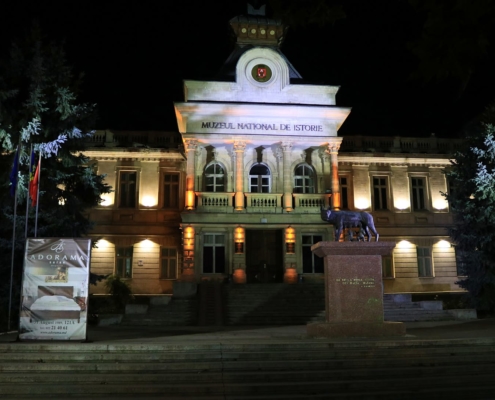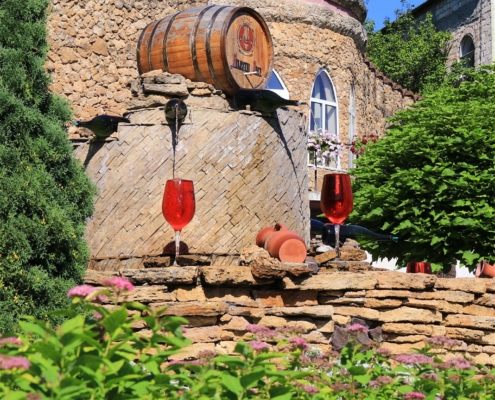
Quick, name a wine- and food-loving European city within range of ancient monasteries and world-class vineyards! You’re probably thinking of something in France or Italy. How about Chişinău, Moldova? Now better connected than ever by air to western Europe, this leafy capital makes an appealing – and affordable – short break, offering a nice mix of accessible sights, hopping nightlife and post-Soviet exoticism.
Day One
Morning Day one is walking day, so fuel up at Coffee Molka, a quirky cafe that doubles as a coffee museum. This is where you can ogle antique presses and grinders while sipping coffee brewed over hot sand – an old Turkish method; make sure to ask for a demo (youtube.com). From here it’s a short stroll over to the Army Museum, home to a moving exhibition on repression under the Soviets. The deportations and other crimes committed by Stalin in Moldova are documented in vivid detail through dioramas, collages and sometimes graphic videos.
Once you’re sufficiently introduced to the horrors of Chişinău’s past, it’s time to enjoy the pleasures of its present. Walk northwest on the city’s main drag, B-dul Ştefan cel Mare, which contains some fine examples of fin-de-siècle architecture such as the City Hall (at No 83) and the Organ Hall (at No 81), as well as some imposing Soviet specimens. Veer southwest a couple of blocks to the grand National Archaeology & History Museum, marked by an old Soviet helicopter in the courtyard. It capably documents the 2000-year-long history of Moldova with some 300,000 artefacts. Art aficionados may prefer the well-rounded National Art Museum nearby. Both museums are on Str 31 Aug 1989, a bar and restaurant hub, so you’re well positioned for lunch.
Afternoon
Sample as much Moldovan cuisine as you can in 48 hours – it’s similar to Romanian food, with Russian influences. Start at Pani Pit, where Moldovan country dishes like grilled rabbit mingle with beef tartare. Eat in the peasant-themed downstairs dining room or outside in the pleasant courtyard.
Chişinău’s spiritual heart lies in two adjacent central parks; explore these after lunch. Grădina Publică Ştefan cel Mare şi Sfînt is named after Moldova’s national hero, Ştefan cel Mare, a warrior prince who defended the borders of the Moldavian principality from the Ottomans more than 500 years ago. His statue is in the southeast corner of the park. Nearby, Chişinău’s very own Arc de Triomphe marks the entrance to Parcul Catedralei. Here you’ll find the city’s main Moldovan Orthodox church, the 19th-century Nativity of Christ Metropolitan Cathedral with its impressive bell tower. You might get lucky and catch a service or a wedding here, accompanied by beautiful Orthodox choral music (youtube.com).
Pedestrianised Str E Doga abuts the northeast side of Parcul Catredalei and is lined with outdoor bars and restaurants. You’d be forgiven for getting an early start on sampling a few Moldovan wines at this point. Or, if you have more museums in you, grab a coffee at delightful Crème de la Crème, then walk 10 minutes through pleasant back streets to the intriguing Pushkin Museum on the site where Alexander Pushkin spent three years in exile in the 1820s. The Russian national poet’s amorous escapades in Moldova during this period were legendary.
Evening
Get cleaned up for a night out and head back to lively Str 31 Aug 1989 for a warm-up drink at one of the open-air cafes near the corner of Str Puşkin. For dinner, drop in to Vatra Neamului for round two of your Moldovan cuisine education. Start with plăcinte (stuffed pastries) – order them with brânză, or ewe cheese. For the main course try supă domească (literally ‘princely soup’), loaded with vegetables, meat and herbs, with a side of mămăligă (boiled corn meal mash) and sour cream. Wash it down with a glass of Purcari, from one of Moldova’s best boutique wineries, while a talented duet plays traditional folk music (youtube.com).
You’re in the heart of the entertainment zone, so it won’t be difficult to find a watering hole after dinner. Déjà Vu is a notorious basement bar known for elaborate shots and dirty dancing. On weekends, you’ll inevitably end up at throbbing Military Pub, where those so inclined can gyrate until sunrise.
Day Two
Morning Sure, the museums were interesting, but we know why you’re really here: the wine. Moldova was the Rhone Valley of the Soviet Union, and two of the largest wineries in the world are within 20km of Chişinău: Mileştii Mici and Cricova. Mileştii Mici has the records (200km of tunnels and 1.5 million bottles of wine), but Cricova, with a mere 120km of tunnels, is more charming and has better wine. Visitor numbers are limited, so book a tour well in advance through a travel agent in Chişinău. Lunch is recommended at both wineries – medieval-style dining in the caves is an experience in its own right.
Don’t care for wine? Plan a half-day excursion to Orheiul Vechi (Old Orhei), home to Moldova’s most famous sight, a mesmerising hilltop cave monastery overlooking the Răut River 50km north of Chişinău.
Afternoon
You have a few options for the afternoon, depending on how much wine you tasted earlier. Serious oenophiles can take in another winery, perhaps a smaller boutique one such as Château Vartely, 50km north of Chişinău, or Château Cojuşna, 13km northwest. Others might consider a siesta followed by a visit to another museum, such as the National Museum of Ethnography & Natural History, which has some wonderful dioramas depicting Moldovan folk life, extensive displays on Moldova’s flora and fauna, and an old dinothere (prehistoric elephant-like mammal) skeleton.
Evening
Your final evening in Chişinău is all about culture. Performances at the Opera & Ballet Theatre are a real steal at just 50 lei to 200 lei (US$2.50 to US$10). The schedule is erratic, and the theatre closes for much of the summer, but you can usually bank on a Sunday 4pm show. Afterwards, take a seat on the heavenly outdoor terrace at Mojito, the best people-watching address in the city. Order a drink – watch out, they are huge – or, if you’ve had enough booze, a coffee.
You can stay here for a sushi dinner, but we recommend taking a 10-minute taxi ride to Gok-Oguz, a Gagauzian restaurant. The Gagauz are a little-known Christian-Turkic ethnic minority with their own autonomous region in Moldova. A meal here is the next best thing to actually visiting the region. The Turkish-, Russian- and Romanian-influenced menu is heavy on stewed meats, especially lamb – try the pirinci (mutton pilaf). Sit inside or outside in cosy nooks, open one last bottle of Purcari, and toast your discovery of Europe’s least-known city break.
Source: LonelyPlanet








